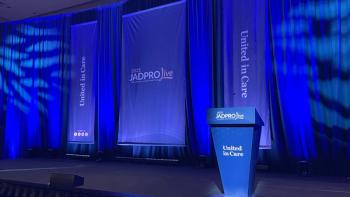
Texas Study Demonstrates Need for Electronic Patient-Report Outcomes in Oncology Centers
A presentation at the 2021 American Society of Clinical Oncology Meeting demonstrated that the use of electronic patient-reported outcomes in community oncology centers improved symptom-management.
The implementation of electronic patient-reported outcomes (ePRO) in community oncology clinics in Texas proved to be feasible and necessary for symptom monitoring among patients receiving chemotherapy, according to a poster presentation at the 2021 ASCO Annual Meeting.
The study noted that utilization of ePROS began high and began to diminish, calling for health care providers to address barriers and optimize compliance.
A collaborative 2-part study between Texas Oncology and Navigating Cancer demonstrated that symptom-management times can be improved through the utilization of digital health care tools and real-time clinical informatics. While the COVID-19 pandemic placed limitations on complete implementations, it also exacerbated the need for modernized communication between patients and health care providers. The results of this study support the use of ePROS to improve symptom management in routine clinical oncology care.
“ePRO symptom management has been shown to be effective in improving outcomes. Pivotal data that showed a reduction in health care resource utilization and improved survival in the academic setting is compelling to promote use,” described Debra Patt, MD, PHD, MBA, FASCO, executive vice-president of Texas Oncology, during a virtual presentation of the poster. “Community oncology practices are well-positioned to replicate these outcomes but have yet to be studied at scale.”
Prior to implementation, Navigating Cancer’s implementation specialist and organizational operation leaders collaborated to prepare a training and rollout plan. The specialist then educated clinical teams via recorded virtual sessions which will continue to be made available to staff for future use.
Upon initiating new systematic therapy for cancer diagnoses, Patients were invited to enroll in the Navigating Cancer ePRO platform.A clinical team introduced patients to the digital monitoring program and provided educational materials. Once patients authorized enrollment, they had access to additional guidance though the electronic interface.
Implementation reached across 7 Texas regions and 210 sites of service. There were weekly PRO assessments for a 6-month period, during which time, patients were observed via the ePRO health tracker. The tracker, a modified PRO CTCAE symptom instrument, included 14 of the most common cancer-related symptoms. Patients were queried about medication compliance and daily side effects. If a side effect presented itself, patients were asked to describe, in lengthier detail, the frequency of their pain and whether it interfered with their daily activities.
The majority of patients were older than 65 years, and White (73%) or non-Hispanic/Latino (75%).
Notable findings included the preference for self-reported SMS text messaging data collection as opposed to email or clinic collection: 89% of participants demonstrated a preference for SMS in comparison to email (6%) and manual collection (5%). Although compliance for participating patients remained fairly consistent, in week 10, response rates fell from 73% to 53%. Findings noted a higher compliance rate among patients undergoing oral therapy as opposed to intravenous therapy (73% vs. 61%, respectively).
Since this symptom-reporting instrument was completely implemented during the pandemic, possible compliance barriers could be the result of COVID-19: lack of caregiver presence, practice workflow alterations, clinician burnout, and new mental health stressors all have the capability to affect participation performance with the new technology. Furthermore, a lack of reminders or prompts for patients to respond to might also be responsible for non-reporting patients.
“We sought to understand implementation facilitators and barriers. I would say facilitators include patient and staff engagement, clinician reinforcement on the benefits of the digital monitoring program, and the ease of the use of the tool,” Patt summarized. “Although the COVID-19 pandemic introduced barriers to implementation, it also accelerated the need for modernization of communication between patients and clinicians. Utilization of real-time clinical informatics and digital health care tools can help provide just-in-time symptom management.”
“Most importantly,” Patt added, “implementation of ePROs for symptom monitoring across a large, multisite statewide cancer practice is feasible. And our findings support the inclusion of ePROs in routine clinical care.”
Future studies will address different populations of patients with cancer to continue optimizing the program. Symptom alert enhancements will also seek to strengthen patient engagement and discourage staff fatigue.
Reference:
Patt DA, Wilfong LS, Hudson KE, et al., J Clin Oncol 39, 2021 (suppl 15; abstr 12103),
Newsletter
Knowledge is power. Don’t miss the most recent breakthroughs in cancer care.

















































































